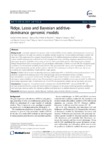Please use this identifier to cite or link to this item:
http://www.alice.cnptia.embrapa.br/alice/handle/doc/1022575| Title: | Ridge, Lasso and Bayesian additive dominance genomic models. |
| Authors: | AZEVEDO, C. F.  RESENDE, M. D. V. de   SILVA, F. F. e   VIANA, J. M. S.   VALENTE, M. S. F.   RESENDE JUNIOR, M. F. R.   MUÑOZ, P.   |
| Affiliation: | Camila Ferreira Azevedo, UFV; MARCOS DEON VILELA DE RESENDE, CNPF; Fabyano Fonseca e Silva, UFV; José Marcelo Soriano Viana, UFV; Magno Sávio Ferreira Valente, UFV; Márcio Fernando Ribeiro Resende Jr, Florida Innovation Hub; Patricio Muñoz, University of Florida. |
| Date Issued: | 2015 |
| Citation: | BMC Genetics, v. 16, art. 105, Aug. 2015. 13 p. |
| Description: | Background: A complete approach for genome-wide selection (GWS) involves reliable statistical genetics models and methods. Reports on this topic are common for additive genetic models but not for additive-dominance models. The objective of this paper was (i) to compare the performance of 10 additive-dominance predictive models (including current models and proposed modifications), fitted using Bayesian, Lasso and Ridge regression approaches; and (ii) to decompose genomic heritability and accuracy in terms of three quantitative genetic information sources, namely, linkage disequilibrium (LD), co-segregation (CS) and pedigree relationships or family structure (PR). The simulation study considered two broad sense heritability levels (0.30 and 0.50, associated with narrow sense heritabilities of 0.20 and 0.35, respectively) and two genetic architectures for traits (the first consisting of small gene effects and the second consisting of a mixed inheritance model with five major genes). Results: G-REML/G-BLUP and a modified Bayesian/Lasso (called BayesA*B* or t-BLASSO) method performed best in the prediction of genomic breeding as well as the total genotypic values of individuals in all four scenarios (two heritabilities x two genetic architectures). The BayesA*B*-type method showed a better ability to recover the dominance variance/additive variance ratio. Decomposition of genomic heritability and accuracy revealed the following descending importance order of information: LD, CS and PR not captured by markers, the last two being very close. Conclusions: Amongst the 10 models/methods evaluated, the G-BLUP, BAYESA*B* (−2,8) and BAYESA*B* (4,6) methods presented the best results and were found to be adequate for accurately predicting genomic breeding and total genotypic values as well as for estimating additive and dominance in additive-dominance genomic models. |
| Thesagro: | Parâmetro Genético |
| Keywords: | Modelo Bayesiano Genética quantitativa Melhoramento genético Dominance genomic models Bayesian methods Lasso methods Selection accuracy |
| DOI: | 10.1186/s12863-015-0264-2 |
| Type of Material: | Artigo de periódico |
| Access: | openAccess |
| Appears in Collections: | Artigo em periódico indexado (CNPF)  |
Files in This Item:
| File | Description | Size | Format | |
|---|---|---|---|---|
| 2015APIDeonRidge.pdf | 467,28 kB | Adobe PDF |  View/Open |









